KR-ERS
Item Prepared for ERS Registration
1. In case of ships assigned with KR ERS notation, the following data are inputted and stored into the database, so that a prompt activation of KR ERS program can be made possible in an emergency situation.
-
- 1) Hull Offset data (Hull form data) input [Ref. to Fig. 1~2]
-
- Hull form date input
-
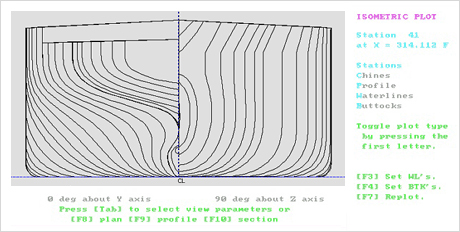
- Fig.1) 301K VLCC Body Plan
-

- Fig.2) Moss Type LNG Carrier
-
- 2) Compartment Offset data input [Ref. to Fig. 3~7]
-
- watertight compartment form data input
-
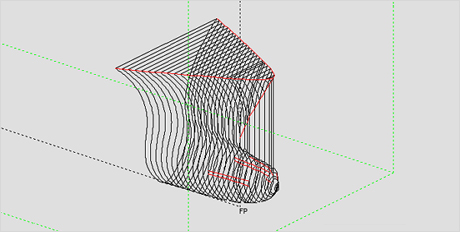
- Fig.3) FPT of LNG Carrier
-

- Fig.4) No1. Cargo Tank of LNG Carrier
-
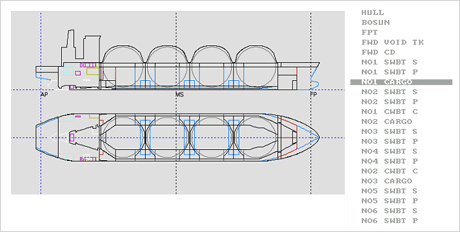
- Fig.5) Defined Tanks Arrangement of LNG Carrier
-
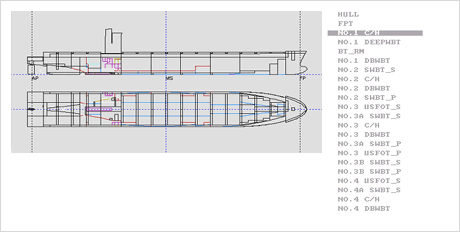
- Fig.6) Tanks Arrangement of 5500TEU Container
-
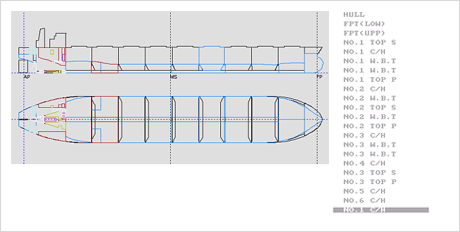
- Fig.7) Tanks Arrangement of 161K Bulk Carrier
-
- 3) Section Modulus Editor (Ref. to Fig. 8)
-
-

- Fig.8) Midship Section of VLCC
-
-
- 4)Ship Data Input (Ref. to Fig. 9~10)
-
- Light Ship Data (Weight, Center) input
- Input a specific character of cargos and tanks
- Hydrostatic Table input manually/automatically
- Cross Curves input manually/automatically
- Bonjean Table input manually/automatically
- Required GM Curves input manually/automatically
- Light Weight Distribution data input
- Allowable Strength (S.F/B.M, SAG/HOG, SEA/HARBOR) data input
- Section Modulus Data input manually/automatically
-
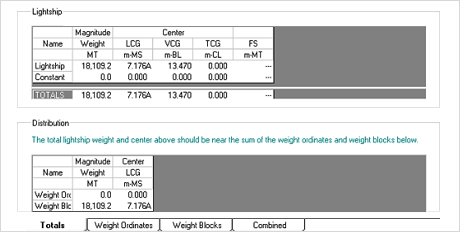
- Fig.9) Light Ship Define Mode
-
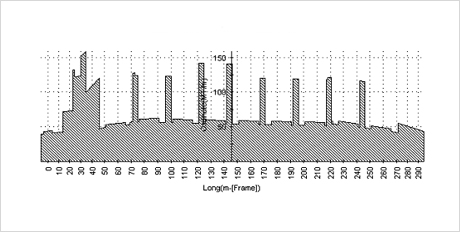
- Fig.10) Light Weight Distribution
2. By using the basic data stored into the database, ERS team carries out following calculations through salvage program in advance.
- Hydrostatic and Bonjeandata Cross curves data Trim and stability summary in intact condition
Available Analysis by Using KR's Salvage Program
1. Intact Loading Condition(Ref. to Fig. 11∼14) Salvage program can check over the intact stability and longitudinal strength like the loading computer used onboard.
-
- 1) Cargo(Tank, Bulk, Container) loading condition input
-
- 2) Using the storage data in Ship Data Entry, following calculations is done.
-
- Trim & Stability
- GZ
- Longitudinal Strength (S.F , B.M)
-
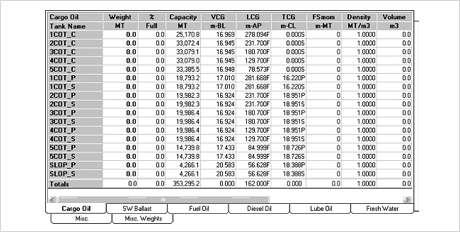
- Fig.11) Tank & Cargo Weights Entry Mode
-

- Fig.12) Trim & Stability Summary
-
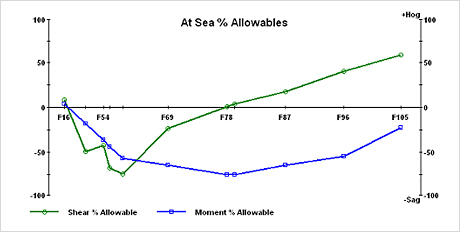
- Fig.13) Strength Summary for Intact Loading Condition
-

- Fig.14) Strength Output Select Mode
2. Salvage Response (Ref. to Fig. 15~19)
- This is the main function of Salvage Program. Salvage Program calculate residual stability, buoyance, longitudinal strength and oil outflow etc, in case of casualties - flooding, stranding and structural damage - , and establish the most effective salvage countermeasure.
-
- 1) Using the intact loading data before the accident
-
- 2) Input a damaged condition such as damaged compartment and structural damage include their
-
location : Salvage program simulate the real accident situation in way of the damaged data (Flooding, stranding, etc) input. Structural damages are also made in the corresponding transverse section.
-
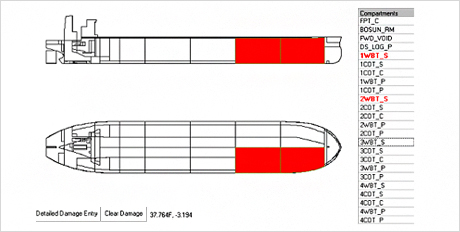
- Fig.15) Specify Damage Compartments
-
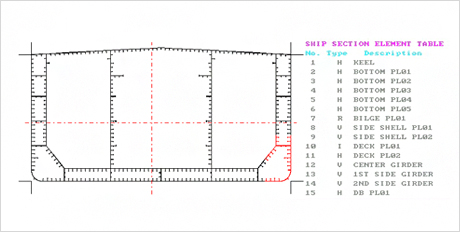
- Fig.16) Specify Structural damage
-
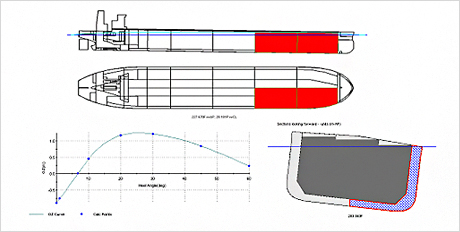
- Fig.17) Free floating after damage
-
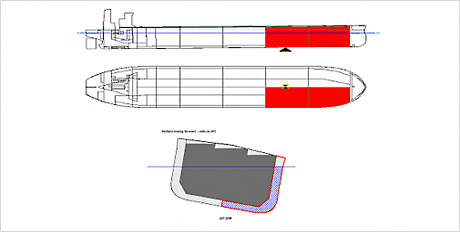
- Fig.18) Damage and strand
-
-
- 3) Wave and Wind Condition Input
-
- Wave
- Salvage Program can calculate the wave height, wavelength and wave position(hogging, sagging)
- consider the wave condition at the place that accident happen. If the sea condition is the real extreme case, the program consider the real wave height, 90~100%L wavelength and sagging condition.
-
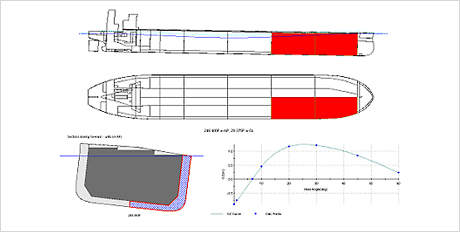
- Fig.19) Considering Wave
- Wind
- Salvage program can consider the effect of wind applied to the side projected plane of the ship. The program need to input a wind speed, coefficient of resistance, wind pressure, area and arm etc.
-
- 4) Following Condition is able to calculate
-
- Free Floating
- One Pinnacle
- Two Pinnacle
- Shelf Stranding
- Stranding after tidal change
-
- 5) Calculation Summary
-
- Stability after Damage
- Strength after Damage : It can consider displacement and bucking align the longitudinal hull direction.
- Outflow/Flooding in Compartment
- Oil Outflow
-
- 6) It is possible to compare and examine the salvage procedure
Technical Review of Salvage Plan
To adjust the excessive trim or heeling cause of flooding or stranding and to guarantee a sufficient stability, or to refloat the stranded ship, follwoing actions should be taken.
- Ballasting or de-ballasting
-
Weight(Oil) Transfer
The weight(oil) or ingress water(ballast water) shall be transferred to other place in the ship by using the available piping system or crane, etc. -
Lightering
The weight(oil) or ingress water(ballast water) shall be transferred outboard by using the available piping system or crane, etc. -
Maintaining the constant air-pressure in damaged compartment
In case of bottom damage, the pressurized air should be flowed into flooded compartment to reserve the compartment buoyance. It can be possible to use the equipment. -
Tidal Change
If the ship is stranded, tidal change is very important. Considering this point help to find the minimum(optimum) way to refloat.




